Cost Analysis and Optimization of Modern Power System Operations
Abstract
1. Introduction
2. Mathematical Formulation
- Ramp Rate Constraint: The increment and decrement in power output of generator per hour in spinning mode is called ramp rate. It is given by % per hour or MW per hour. For the ith unit at time t, the ramp rate constraints are given as follows,
- Minimum Up/Down time constraint: Due to physical and technical restrictions, a generator cannot be shut down or restarted instantaneously. Minimum Up/Down time represents the smallest time interval required that the generating unit must remain online or offline once started up or shut down, respectively. To model these constraints, three integer decision variables are introduced for each generating unit at each time period: ui,t (operational status: ON/OFF), yi,t (startup status), and zi,t (shut-down status). The three integer decision variables are governed by the following equations,
- Start-Up/Shut-Down Cost: This cost is incurred for starting up and shutting down any generating unit from the system and is modelled by the help of the following equations,
3. Implementation and Case Studies
- 1.
- Case 1—Base Scenario (Traditional System):
- 2.
- Case 2—Reserve Constraint:
- 3.
- Case 3—Integration of Renewables and Storage:
- 4.
- Case 4—Demand Flexibility:
3.1. Case 1: Unit Commitment of 10 Thermal Power Plants for Dynamic Load
- Ramp rate limits
- Minimum up/down time requirements
- Power balance between supply and demand
- Start-up and shut-down cost constraints
- u(i,t): Indicates the ON/OFF status of generator i at time t
- y(i,t): Indicates the start-up status of generator i at time t
- z(i,t): Indicates the shutdown status of generator i at time t
- In addition to binary variables, positive continuous variables are defined:
- p(i,t): Power output of generator i at time t
- StC(i,t): Start-up cost of generator i at time t
- SdC(i,t): Shutdown cost of generator i at time t
3.2. Case 2: Unit Commitment of 10 Thermal Power Plants for Given Dynamic Load with Spinning Reserve Constraints
- Cover sudden increases in load,
- Compensate for unexpected drops in renewable generation, or
- Respond to generator outages or other unforeseen contingencies.
3.3. Case 3: Unit Commitment of Thermal Units with Energy Storage System and Wind Energy for 24 h Dynamic Load
- Maximum state of charge (SOCₘₐₓ): 300 MW
- Initial state of charge (SOC0): 100 MW at the start of the operating horizon
- Minimum charging/discharging power: 0 MW
- Maximum charging/discharging power: 0.2 × SOCₘₐₓ = 60 MW
- Charging efficiency: 95%
- Discharging efficiency: 90%
3.4. Case 4: Unit Commitment Demand Flexibility Constraint
- At the consumer side through demand response programs and smart appliances,
- And at the supply side via technologies like battery energy storage systems (BESS).
- Maximum allowable deviation from baseline demand (upward or downward),
- Temporal balancing to ensure total shifted demand is met within the operational window,
- And potential cost penalties or incentives associated with shifting loads.
4. Results and Discussion
- Case 1 examines a traditional power system with 10 thermal units, resulting in an operating cost of USD 4.8524 × 105, with fuel, start-up, and shut-down costs amounting to USD 484,797, USD 442.1, and USD 0, respectively. This forms the baseline for comparison.
- Case 2 incorporates spinning reserve requirements (assumed at 40%) for enhanced reliability. With a 55% load reduction, the operating cost drops significantly to USD 2.1090 × 105, and start-up/shut-down costs are reduced to USD 199.4 and USD 213.4, respectively, highlighting the cost of maintaining reserve margins.
- Case 3 transitions to a modern power system configuration, involving only four thermal units, wind energy, and an energy storage system (ESS). This integration results in a notably lower operating cost of USD 2.2336 × 105, emphasizing both economic efficiency and enhanced flexibility from renewables and ESS.
- Case 4 explores the impact of demand-side flexibility (DSF). By enabling 10% demand flexibility, the system achieves a further cost reduction to USD 2.0965 × 105, demonstrating the potential of smart grid technologies and responsive consumption in optimizing operations.
5. Sensitivity Analysis
6. Comparison of Case 1 and Case 2 at Same Load
7. Key Insights
- Unit commitment optimization significantly reduces operating costs when properly modelled with realistic system constraints.
- Incorporating spinning reserves improves system reliability but requires additional generation margin and slightly increases startup/shutdown costs.
- Renewables and ESS not only reduce fuel dependence but also enhance system flexibility and lower costs.
- Demand-side management, even with modest flexibility, presents a powerful tool for achieving both economic and operational benefits.
8. Conclusions
Key Findings
- Integration of renewable energy resources leads to a significant reduction in fossil fuel-based power generation and overall operating cost, promoting both economic and environmental benefits.
- Energy Storage Systems (ESS) play a crucial role in enhancing power system flexibility. Their ability to shift energy temporally allows better integration of variable renewable generation and supports grid stability.
- From both the generation and demand perspective, ESS becomes increasingly important with higher levels of renewable penetration. This reduces the fuel consumption of thermal units, contributing to lower operational costs.
- The use of ESS and renewables also aids in mitigating the environmental impact of conventional generation and enhances energy security by reducing dependency on fossil fuels.
- The study of demand-side flexibility (Case 4) reveals that even modest levels of flexibility (e.g., 10%) lead to notable reductions in operating costs, highlighting the value of smart appliances and consumer responsiveness in modern grid operations.
Author Contributions
Funding
Institutional Review Board Statement
Informed Consent Statement
Data Availability Statement
Conflicts of Interest
Nomenclature
| Indices | |
| generating unit (thermal) | |
| Time duration | |
| blocks chosen for piece-wise linear cost function | |
| Parameters | |
| Dynamic load | |
| Coefficients of cost | |
| At the operational horizon specifies the time for which ith generator is on/off | |
| Initial and final value of power in kth block of linear cost of thermal unit i (MW). | |
| Initial and final value of cost for block k of linear cost for thermal unit i ($/h). | |
| Minimum/maximum power limitation of thermal unit | |
| Length of block k of linear cost of thermal generators i (MW) | |
| Slope for cost in segment k of linear cost function ($/MW) | |
| Minimum/Maximum time dependent power limit | |
| ith thermal unit’s up/down ramp limitations | |
| Ramp limit of start-up/shutdown thermal unit | |
| Generator’s minimum up/down time | |
| Time dependent shutdown/start-up cost of thermal unit i | |
| Shutdown/start-up cost of thermal unit i | |
| Wind energy at time t | |
| Limits of energy storage system’s state of charge | |
| Variables | |
| Generated power of thermal unit i at time t (MW) | |
| Objective function | |
| State of charge of the energy storage system at time t (MW) | |
References
- Padhy, N.P. Unit commitment—A Bibliographical Survey. IEEE Trans. Power Syst. 2004, 19, 1196–1205. [Google Scholar] [CrossRef]
- Mollahassani-pour, M.; Rashidinejad, M.; Abdollahi, A. Spinning reserve contribution using unit responsibility criterion incorporating preventive maintenance scheduling. Int. J. Electr. Power Energy Syst. 2015, 73, 508–515. [Google Scholar] [CrossRef]
- Bouffard, F.; Ortega-Vazquez, M. The value of operational flexibility in power systems with significant wind power generation. In Proceedings of the 2011 IEEE Power and Energy Society General Meeting, Detroit, MI, USA, 24–29 July 2011; pp. 1–5. [Google Scholar]
- Abu-Sharkh, S.; Arnold, R.J.; Kohler, J.; Li, R.; Markvart, T.; Ross, J.N.; Yao, R. Can microgrids make a major contribution to UK energy supply? Renew. Sustain. Energy Rev. 2006, 10, 78–127. [Google Scholar] [CrossRef]
- Soshinskaya, M.; Crijns-Graus, W.H.; Guerrero, J.M.; Vasquez, J.C. Microgrids: Experiences, barriers and success factors. Renew. Sustain. Energy Rev. 2014, 40, 659–672. [Google Scholar] [CrossRef]
- Lasseter, R.H. Microgrids. In Proceedings of the 2002 IEEE Power Engineering Society Winter Meeting, New York, NY, USA, 27–31 January 2002; Volume 1, pp. 305–308. [Google Scholar]
- Liang, H.; Zhuang, W. Stochastic modeling and optimization in a microgrid: A survey. Energies 2014, 7, 2027–2050. [Google Scholar] [CrossRef]
- Peesapati, R.; Yadav, V.K.; Kumar, N. Flower pollination algorithm based multi-objective congestion management considering optimal capacities of distributed generations. Energy 2018, 147, 980–994. [Google Scholar] [CrossRef]
- Klyapovskiy, S.; You, S.; Cai, H.; Bindner, H.W. Incorporate flexibility in distribution grid planning through a framework solution. Int. J. Electr. Power Energy Syst. 2019, 111, 66–78. [Google Scholar] [CrossRef]
- Lehtola, T.; Zahedi, A. Solar energy and wind power supply supported by storage technology: A review. Sustain. Energy Technol. Assess. 2019, 35, 25–31. [Google Scholar] [CrossRef]
- Alirezazadeh, A.; Rashidinejad, M.; Abdollahi, A.; Afzali, P.; Bakhshai, A. A new flexible model for generation scheduling in a smart grid. Energy 2020, 191, 116438. [Google Scholar] [CrossRef]
- Yang, Z.; Li, K.; Niu, Q.; Xue, Y. A comprehensive study of economic unit commitment of power systems integrating various renewable generations and plug-in electric vehicles. Energy Convers. Manag. 2017, 132, 460–481. [Google Scholar] [CrossRef]
- Shahbazitabar, M.; Abdi, H. A novel priority-based stochastic unit commitment considering renewable energy sources and parking lot cooperation. Energy 2018, 161, 308–324. [Google Scholar] [CrossRef]
- Miller, L.; Carriveau, R. Energy demand curve variables–An overview of individual and systemic effects. Sustain. Energy Technol. Assess. 2019, 35, 172–179. [Google Scholar] [CrossRef]
- Zhang, B.; Kezunovic, M. Impact on power system flexibility by electric vehicle participation in ramp market. IEEE Trans. Smart Grid 2015, 7, 1285–1294. [Google Scholar] [CrossRef]
- Schachter, J.A.; Mancarella, P.; Moriarty, J.; Shaw, R. Flexible investment under uncertainty in smart distribution networks with demand side response: Assessment framework and practical implementation. Energy Policy 2016, 97, 439–449. [Google Scholar] [CrossRef]
- Lannoye, E.; Flynn, D.; O’Malley, M. Evaluation of power system flexibility. IEEE Trans. Power Syst. 2012, 27, 922–931. [Google Scholar] [CrossRef]
- Papaefthymiou, G.; Grave, K.; Dragoon, K. Flexibility Options in Electricity Systems; Project number: POWDE14426; Ecofys: Utrecht, The Netherlands, 2014. [Google Scholar]
- Roukerd, S.P.; Abdollahi, A.; Rashidinejad, M. Probabilistic-possibilistic flexibility-based unit commitment with uncertain negawatt demand response resources considering Z-number method. Int. J. Electr. Power Energy Syst. 2019, 113, 71–89. [Google Scholar] [CrossRef]
- Nikoobakht, A.; Aghaei, J.; Shafie-Khah, M.; Catalao, J.P. Assessing increased flexibility of energy storage and demand response to accommodate a high penetration of renewable energy sources. IEEE Trans. Sustain. Energy 2018, 10, 659–669. [Google Scholar] [CrossRef]
- Kumar, V.; Naresh, R.; Singh, A. Investigation of solution techniques of unit commitment problems: A review. Wind Eng. 2021, 45, 1689–1713. [Google Scholar] [CrossRef]
- Alirezazadeh, A.; Rashidinejad, M.; Afzali, P.; Bakhshai, A. A new flexible and resilient model for a smart grid considering joint power and reserve scheduling, vehicle-to-grid and demand response. Sustain. Energy Technol. Assess. 2021, 43, 100926. [Google Scholar] [CrossRef]
- Sachan, S.; Gupta, C.P. Analysis of contingent conditions in power system. In Proceedings of the 2014 Students Conference on Engineering and Systems, Allahabad, India, 28–30 May 2014; pp. 1–5. [Google Scholar] [CrossRef]
- Sachan, S.; Mishra, S.; Øyvang, T.; Bordin, C. Minimizing active power losses and voltage deviations for reactive power planning considering bus vulnerability. Next Res. 2025, 2, 100633. [Google Scholar] [CrossRef]
- Mccarl, B.A.; Meeraus, A.; Van der Eijk, P.; Bussieck, M.; Dirkse, S.; Steacy, P.; Nelissen, F. McCarl GAMS User Guide; GAMS Development Corporation: Washington, DC, USA, 2014. [Google Scholar]
- Liu, L.; Xu, Y.; Kirschen, D.S.; Zhang, Y.; Zhao, J. Reliability-constrained optimal scheduling of multi-microgrid systems with aggregate spinning reserve determination. IEEE Trans. Transp. Electrif. 2025, 11. early access. [Google Scholar]
- Ding, B.; Li, Z.; Li, Z.; Xue, Y.; Chang, X.; Su, J.; Sun, H. Cooperative operation for multiagent energy systems integrated with wind, hydrogen, and buildings: An asymmetric Nash bargaining approach. IEEE Trans. Ind. Inform. 2025, 21, 6410–6421. [Google Scholar] [CrossRef]
- Ademovic, A.; Bisanovic, S.; Hajro, M. A genetic algorithm solution to the unit commitment problem based on real-coded chromosomes and fuzzy optimization. In Proceedings of the Melecon 2010—2010 15th IEEE Mediterranean Electro technical Conference, Valletta, Malta, 26–28 April 2010; pp. 1476–1481. [Google Scholar]
- Carrion, M.; Arroyo, J.M. A computationally efficient mixed-integer and linear formulation and for the thermal and unit. IEEE Trans Power Syst. 2006, 21, 1371–1378. [Google Scholar] [CrossRef]
- Sachan, S. Integration of electric vehicles with optimum sized storage for grid connected photo-voltaic system. AIMS Energy 2017, 5, 997–1012. [Google Scholar] [CrossRef]
- Sachan, S.; Deb, S.; Singh, S.N. Different charging infrastructures along with smart charging strategies for electric vehicles. Sustain. Cities Soc. 2020, 60, 102238. [Google Scholar] [CrossRef]
- Sachan, S.; Deb, S.; Singh, S.N.; Singh, P.P.; Sharma, D.D. Planning and operation of EV charging stations by chicken swarm optimization driven heuristics. Energy Convers. Econ. 2021, 2, 91–99. [Google Scholar] [CrossRef]
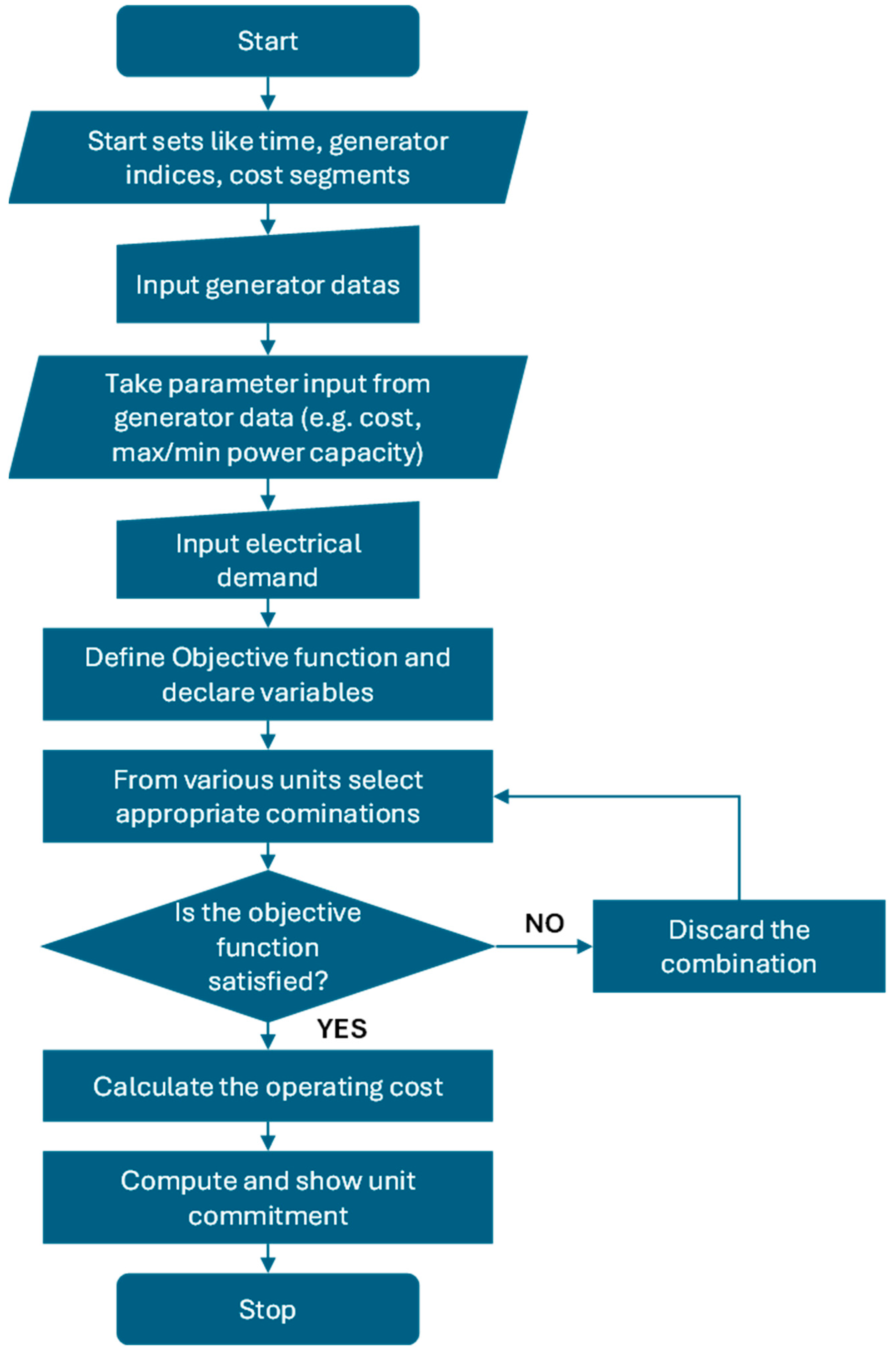
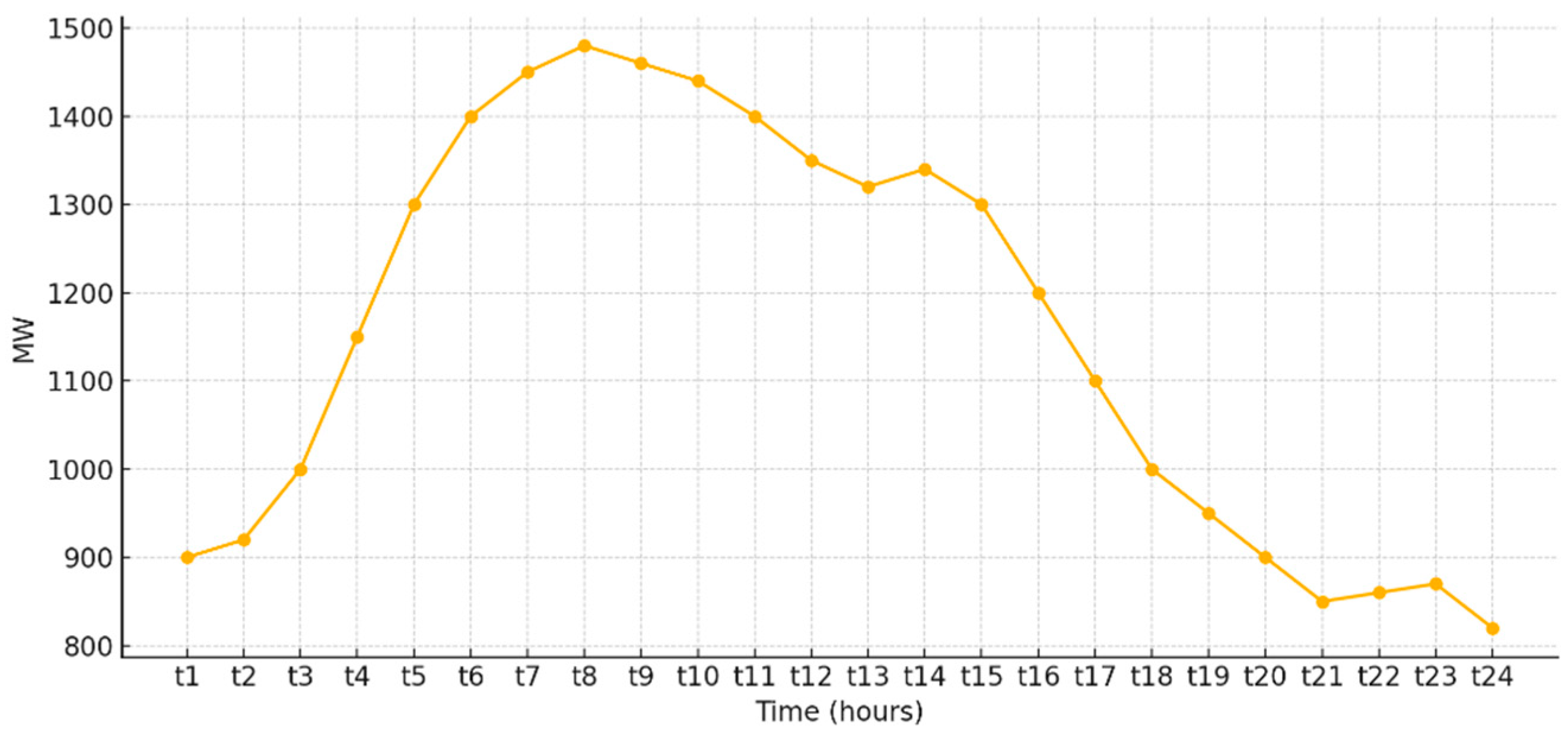

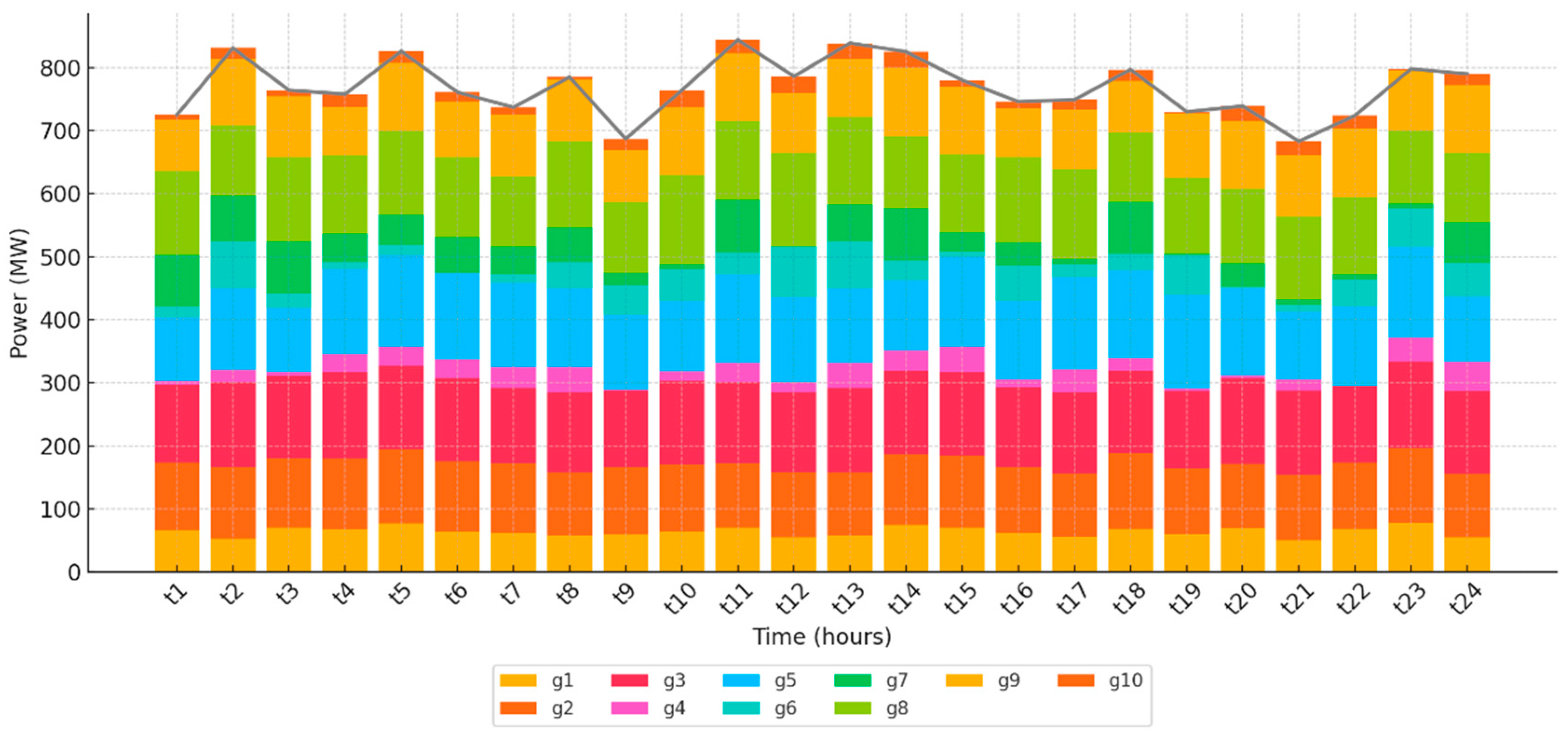




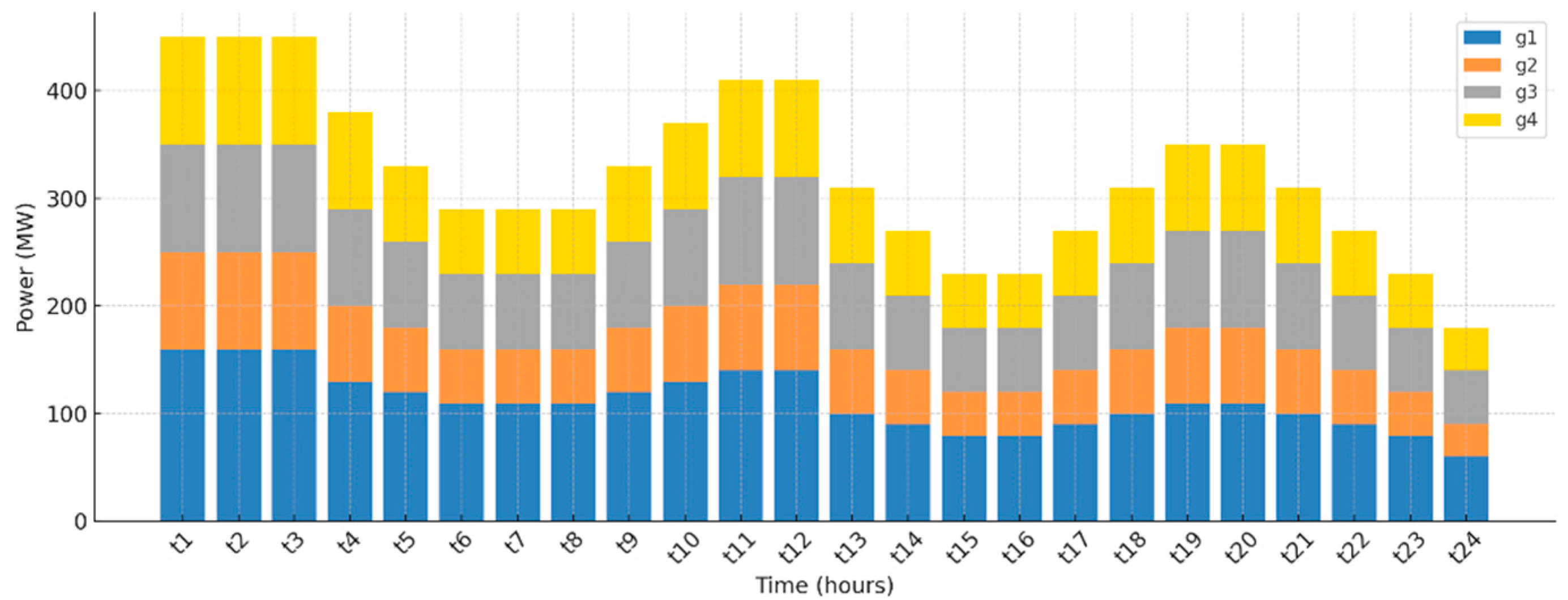
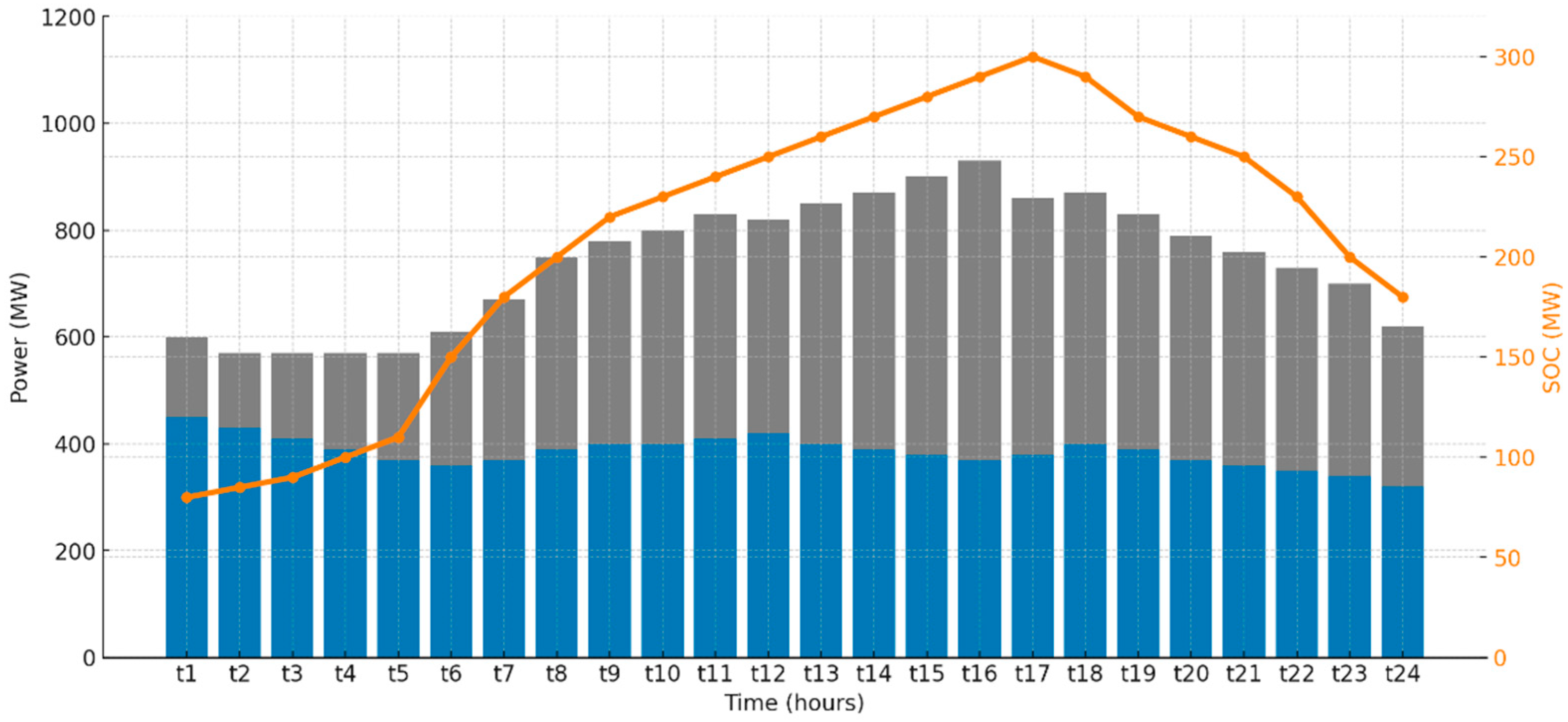
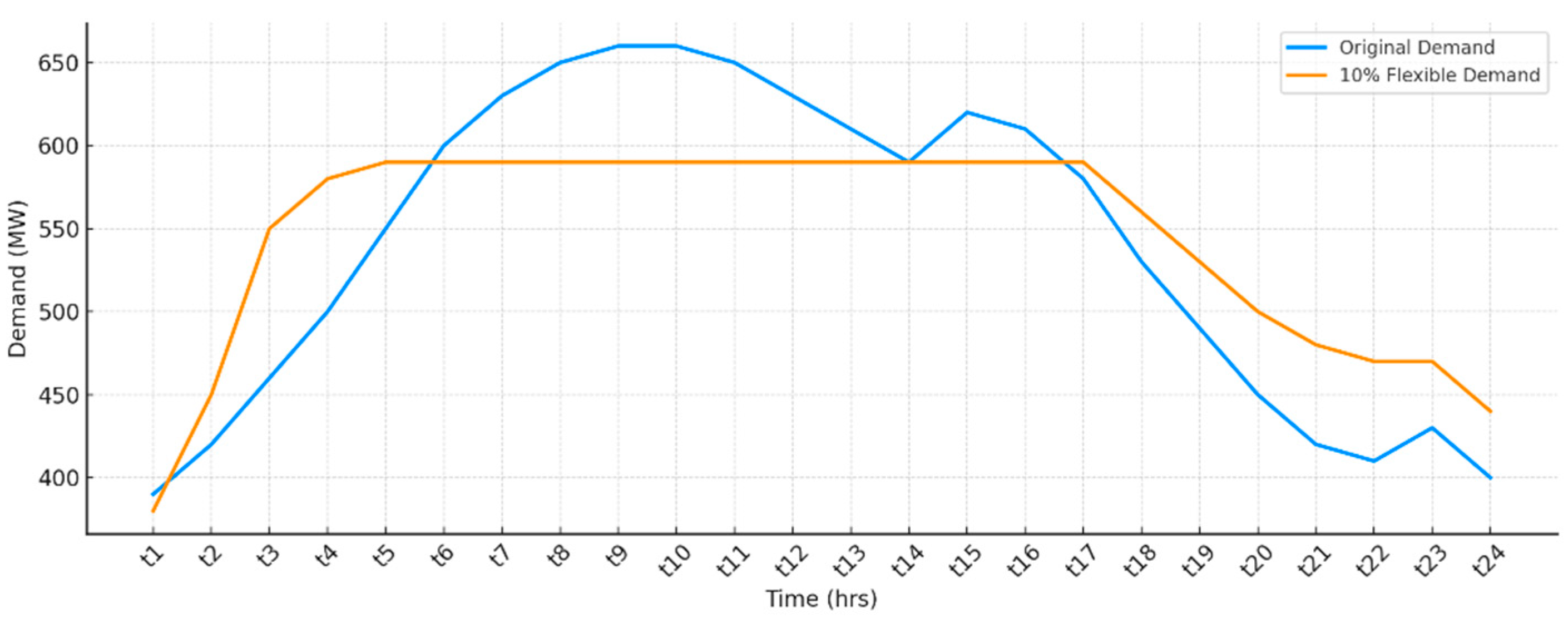

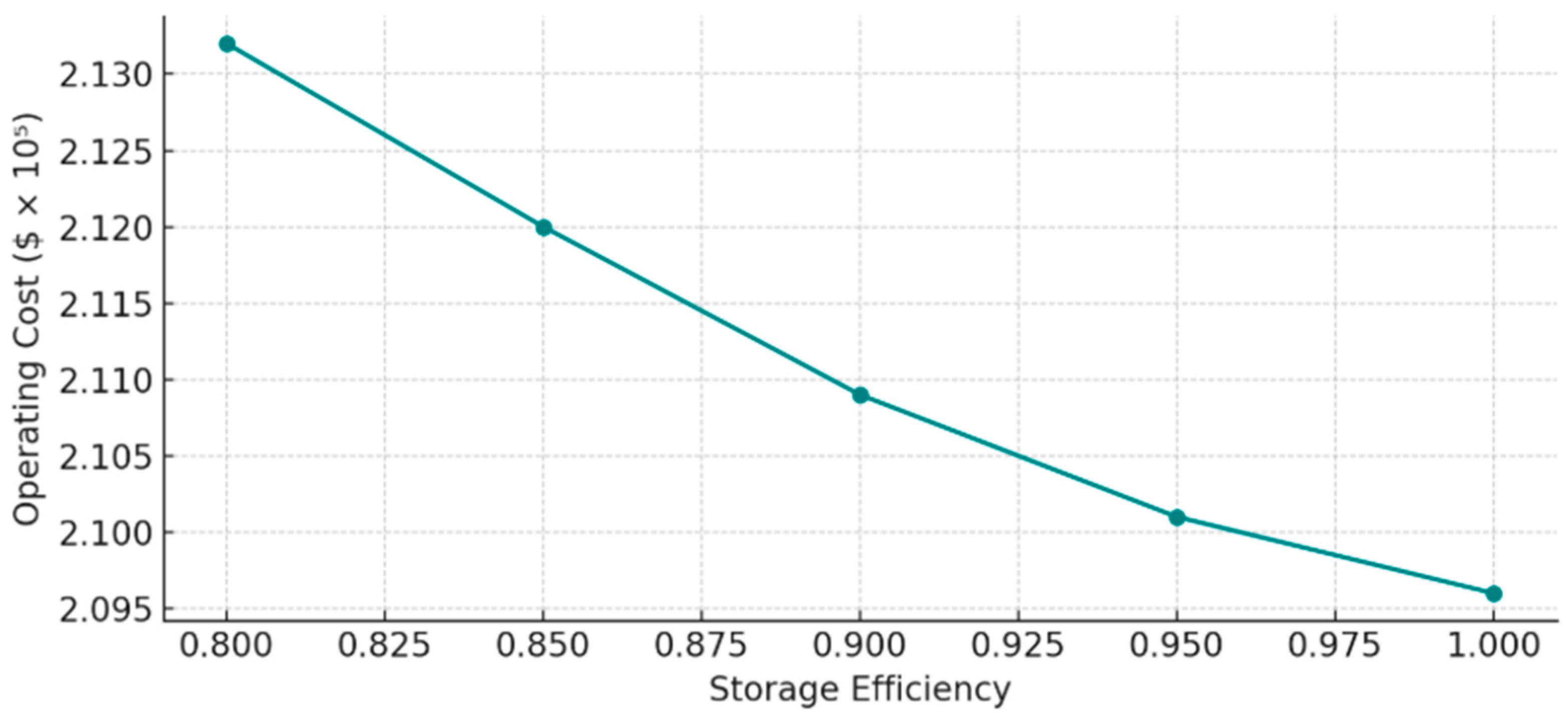
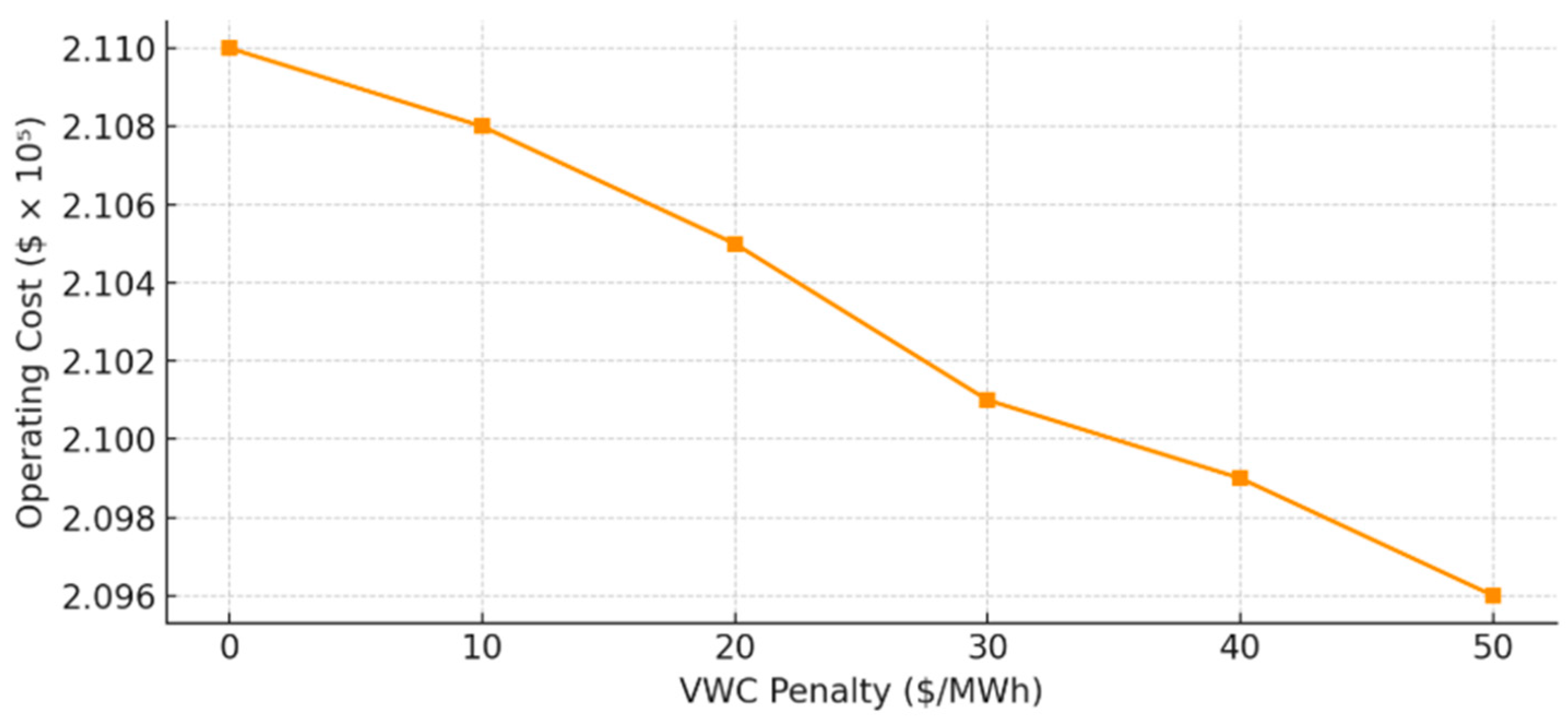
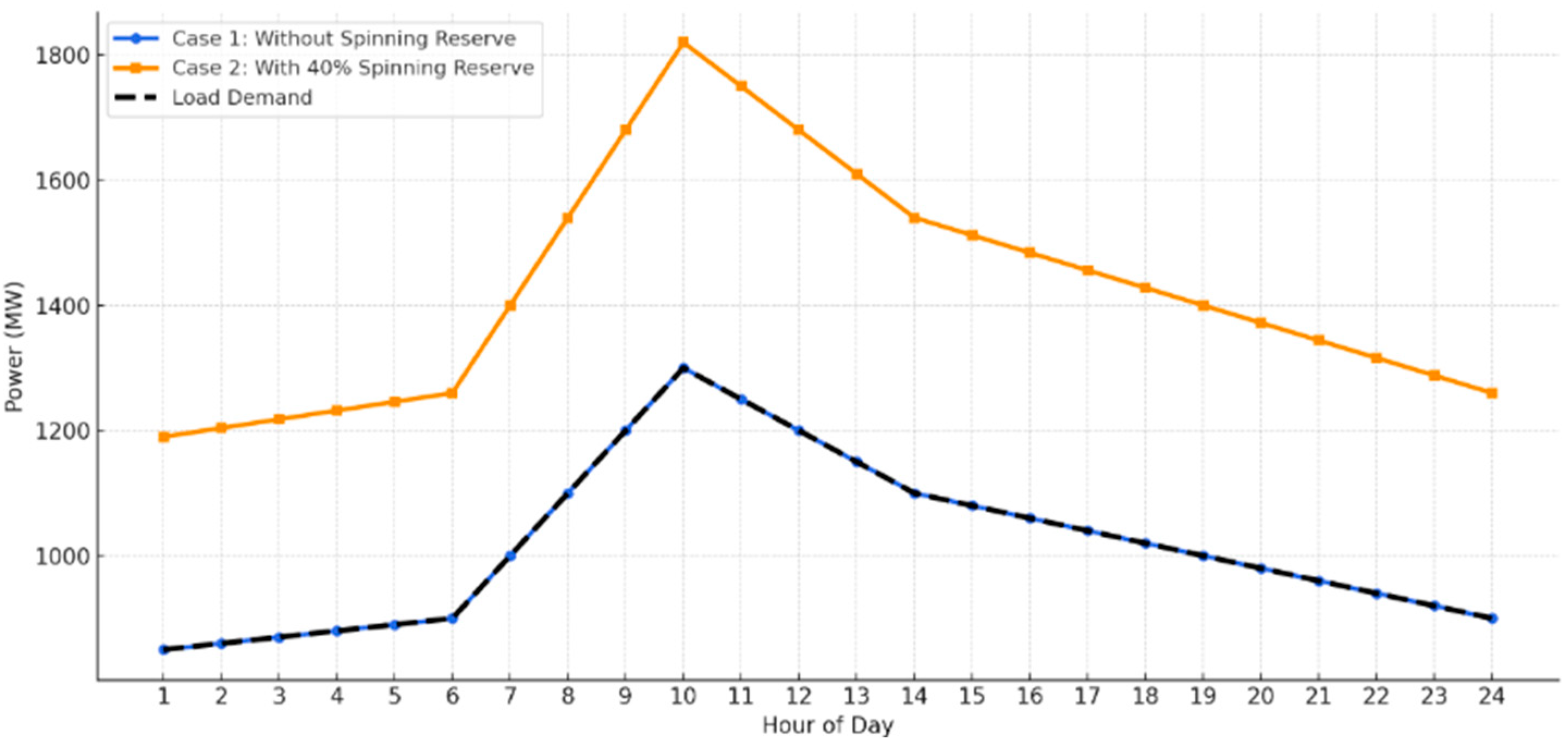
| Unit | a ($/MW2) | b ($/MW) | c ($) | CostSD ($) | costst ($) | RU (MW/h) | RD (MW/h) | UT (h) | DT (h) | SD (MWh) | SU (MWh) | Pmin (MW) | Pmax (MW) | U0 (h) | Uini (h) | S0 (h) |
|---|---|---|---|---|---|---|---|---|---|---|---|---|---|---|---|---|
| g1 | 0.0149 | 12.1 | 82.0 | 42.6 | 42.6 | 40 | 40 | 3 | 2 | 90 | 110 | 80 | 200 | 1 | 0 | 1 |
| g2 | 0.0289 | 12.6 | 50.6 | 50.6 | 50.6 | 64 | 64 | 4 | 3 | 130 | 140 | 120 | 320 | 2 | 0 | 2 |
| g3 | 0.0135 | 13.2 | 100.0 | 57.1 | 57.1 | 30 | 30 | 3 | 2 | 70 | 80 | 50 | 150 | 3 | 0 | 3 |
| g4 | 0.0127 | 13.9 | 105.0 | 47.9 | 47.9 | 104 | 104 | 5 | 3 | 240 | 250 | 250 | 520 | 0 | 3 | 0 |
| g5 | 0.0261 | 15.0 | 72.0 | 56.6 | 56.6 | 56 | 56 | 4 | 2 | 110 | 130 | 100 | 280 | 1 | 0 | 0 |
| g6 | 0.0212 | 29.0 | 141.5 | 141.5 | 141.5 | 30 | 30 | 2 | 2 | 60 | 80 | 50 | 150 | 0 | 0 | 0 |
| g7 | 0.0382 | 32.0 | 100.0 | 57.1 | 57.1 | 60 | 60 | 3 | 2 | 45 | 55 | 30 | 110 | 0 | 0 | 0 |
| g8 | 0.0393 | 30.0 | 100.0 | 57.1 | 57.1 | 30 | 30 | 3 | 2 | 45 | 55 | 30 | 110 | 0 | 0 | 0 |
| g9 | 0.0396 | 15.0 | 25.0 | 50.6 | 50.6 | 22 | 22 | 3 | 2 | 35 | 45 | 20 | 100 | 0 | 0 | 0 |
| g10 | 0.051 | 14.3 | 15.0 | 57.1 | 57.1 | 12 | 12 | 0 | 0 | 30 | 40 | 20 | 60 | 0 | 0 | 0 |
| Scenario | Operating Cost ($) | Energy Storage System Usage | Avoided Emissions | Flexibility Level |
|---|---|---|---|---|
| Base Scenario | 485,240 | None | Baseline | Low |
| Reserve Constraint (Spinning Reserve) | 210,900 | None (Spinning Reserves maintained) | Improved reliability (not quantified) | Medium (Spinning Reserve) |
| Renewables + Storage | 223,360 | Battery Energy Storage System (ESS) | Reduced (due to renewables) | High (Storage + Renewables) |
| Demand Flexibility | 209,650 | Demand-side flexibility (possible storage support) | Reduced (due to demand flexibility) | Highest (Demand Flexibility) |
Disclaimer/Publisher’s Note: The statements, opinions and data contained in all publications are solely those of the individual author(s) and contributor(s) and not of MDPI and/or the editor(s). MDPI and/or the editor(s) disclaim responsibility for any injury to people or property resulting from any ideas, methods, instructions or products referred to in the content. |
© 2025 by the authors. Licensee MDPI, Basel, Switzerland. This article is an open access article distributed under the terms and conditions of the Creative Commons Attribution (CC BY) license (https://creativecommons.org/licenses/by/4.0/).
Share and Cite
Pärl, A.; Singh, P.P.; Palu, I.; Sachan, S. Cost Analysis and Optimization of Modern Power System Operations. Appl. Sci. 2025, 15, 8481. https://doi.org/10.3390/app15158481
Pärl A, Singh PP, Palu I, Sachan S. Cost Analysis and Optimization of Modern Power System Operations. Applied Sciences. 2025; 15(15):8481. https://doi.org/10.3390/app15158481
Chicago/Turabian StylePärl, Ahto, Praveen Prakash Singh, Ivo Palu, and Sulabh Sachan. 2025. "Cost Analysis and Optimization of Modern Power System Operations" Applied Sciences 15, no. 15: 8481. https://doi.org/10.3390/app15158481
APA StylePärl, A., Singh, P. P., Palu, I., & Sachan, S. (2025). Cost Analysis and Optimization of Modern Power System Operations. Applied Sciences, 15(15), 8481. https://doi.org/10.3390/app15158481






